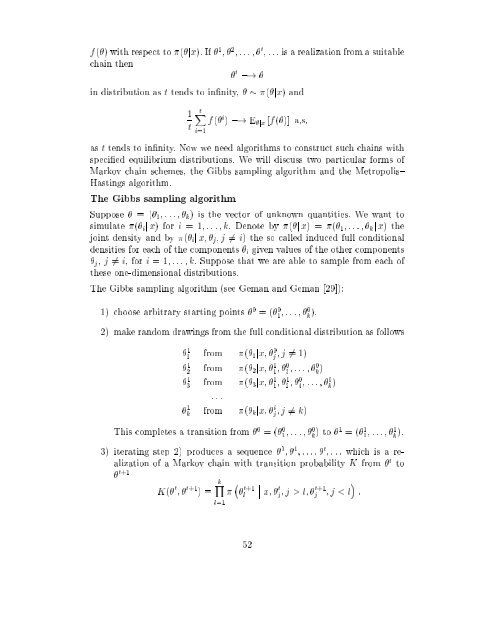Estimation in Financial Models - RiskLab
Estimation in Financial Models - RiskLab
Estimation in Financial Models - RiskLab
Create successful ePaper yourself
Turn your PDF publications into a flip-book with our unique Google optimized e-Paper software.
f() with respect to (jx). If 1 ; 2 ;:::; t ;:::is a realization from a suitable<br />
cha<strong>in</strong> then<br />
t ,! <br />
<strong>in</strong> distribution as t tends to <strong>in</strong>nity, (jx) and<br />
1<br />
t<br />
tX<br />
i=1<br />
f( i ) ,! E jx [f()] a.s.<br />
as t tends to <strong>in</strong>nity. Nowwe need algorithms to construct such cha<strong>in</strong>s with<br />
specied equilibrium distributions. We will discuss two particular forms of<br />
Markov cha<strong>in</strong> schemes, the Gibbs sampl<strong>in</strong>g algorithm and the Metropolis{<br />
Hast<strong>in</strong>gs algorithm.<br />
The Gibbs sampl<strong>in</strong>g algorithm<br />
Suppose = ( 1 ;:::; k ) is the vector of unknown quantities. We want to<br />
simulate ( i j x) for i = 1;:::;k. Denote by (j x) = ( 1 ;:::; k j x) the<br />
jo<strong>in</strong>t density and by ( i j x; j ;j 6= i) the so called <strong>in</strong>duced full conditional<br />
densities for each of the components i given values of the other components<br />
j , j 6= i, for i =1;:::;k. Suppose that we are able to sample from each of<br />
these one-dimensional distributions.<br />
The Gibbs sampl<strong>in</strong>g algorithm (see Geman and Geman [29]):<br />
1) choose arbitrary start<strong>in</strong>g po<strong>in</strong>ts 0 =( 0 1;:::; 0 k).<br />
2) make random draw<strong>in</strong>gs from the full conditional distribution as follows<br />
1 1<br />
from ( 1 jx; 0 j ;j 6= 1)<br />
1 2<br />
from ( 2 jx; 1 1; 0 3;:::; 0 k)<br />
1 3<br />
from ( 3 jx; 1 1; 1 2; 0 4;:::; 0 k)<br />
:::<br />
1 k from ( k jx; i j;j 6= k)<br />
This completes a transition from 0 =( 0 1;:::; 0 k) to 1 =( 1 1;:::; 1 k).<br />
3) iterat<strong>in</strong>g step 2) produces a sequence 0 ; 1 ;:::; t ;::: which is a realization<br />
of a Markov cha<strong>in</strong> with transition probability K from t to<br />
t+1 kY<br />
K( t ; t+1 )=<br />
l=1<br />
t+1<br />
l<br />
x; t j;j >l; t+1<br />
j ;j
















